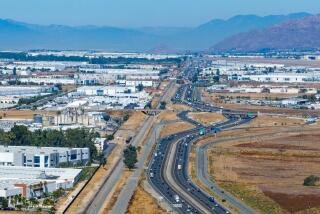After Years of Building on Small Lots, Irvine Co. Makes a Big Change
- Share via
After decades of designing communities with postage-stamp-size lots, Irvine Co. is approaching its latest community with the notion that bigger is better.
Amid rocky terrain and strands of native oak and sycamore trees, company planners are spreading 350 custom home sites across nearly 1,100 acres in the Shady Canyon area of Irvine.
Lot sizes will average about half an acre--the first time the company has put homes on such large spaces.
The development recognizes that too often, million-dollar Southern California homes are stacked next to one another like cars in a crowded parking lot, offering residents little privacy.
Throughout the company-designed city of Irvine, the nation’s largest master-planned community, single-family homes commonly are built about 10 to 12 units per acre. But in Shady Canyon, Irvine officials have arranged for only one or two detached homes on each acre.
The Newport Beach company believes the extra breathing room, combined with a close commute to the Irvine Spectrum business park and other job-rich areas, will become a magnet for home buyers.
Despite signs of a slowing economy, about 1,900 people have signed up with the company to indicate their interest in a lot, a reaction largely spread by word of mouth because no marketing campaign has been launched.
“All of our research reinforces that there’s a significant amount of people in the market that want this kind of environment,” said Donald Moe, a senior vice president at Irvine Co., Orange County’s largest landowner.
With land at a premium, low-density communities such as Shady Canyon are rare in Southern California. Typical home developments are built on small lots, though a few companies are bucking the pattern.
Lennar Communities is selling 250 parcels from a quarter-acre to two acres each at the Bridges, its project in San Diego County’s Rancho Santa Fe. After little more than a year, 60 lots around a private golf course have been sold, said Emile Haddad, the company’s president. Lot prices range from $600,000 to $2.8 million, he said.
But Haddad said he sees no widespread trend toward developing homes on large-scale properties. “Land is so scarce nowadays that builders are trying to maximize its efficiency,” he said.
Although homes have been built on large tracts of land in Coto de Caza and Villa Park in recent years, they haven’t been built in the heart of any major city in the county.
The new lots are expected to range in price from $600,000 to $2 million. When the development opens next summer, the project could turn out to be the most expensive one in Southern California for homes without an ocean view, said John Burns, an analyst at Irvine housing research firm Meyers Group.
Homes in Shady Canyon will be built on jagged lots shaped by the land’s contours, said Bill Martin, director of construction for Irvine Community Development Co., Irvine Co.’s residential arm.
Strict design codes will be enforced in the gated community. To maintain a low profile, streets will be narrower, street lights will be fewer, and homes will be limited to 2,400 square feet on the second level.
Company officials hope the homes blend more into the natural environment, creating a rural feeling among buyers. Palm trees will be banned in Shady Canyon.
Consumers will find streams, canyon views and rolling hills peppered with sage and sandstone.
“We want the landscaping to appear as though it grew out of the environment,” Moe said, “rather than something placed upon it.”
The development also will include a 300-acre golf course, about twice the size of a typical course; 24 detached golf villas; and a 43,000-square-foot clubhouse.
The company remains bullish over the project despite eroding consumer confidence, sliding economic indicators and a weakening stock market, which is a key source of funds for down payments. Despite the threatening economic clouds, demand for luxury homes appears to be firm.
“I think the timing on this project would have been better a year ago,” Burns said. “But I still think the local economy is strong enough that the project will do well.”
More to Read
Sign up for Essential California
The most important California stories and recommendations in your inbox every morning.
You may occasionally receive promotional content from the Los Angeles Times.






